Finite Element Analysis of the Stability of a Sinusoidal Web in Steel and Composite Steel-Concrete Girders
Abstract
1. Introduction
2. Finite Element Analysis
2.1. Properties of the Test Beam
2.2. Geometric Models
2.3. Material Models
2.4. Loading Method and Boundary Conditions
2.5. Validation of Numerical Models
3. Analysis Results and Discussion
4. Conclusions
- The dominant failure of sinusoidal webs, regardless of the presence of the concrete slab, was global buckling, which extended diagonally across several corrugations at the same time, including deformation of the web over its entire height; that is the reason why, in accordance with the hypothesis of M. T. Huber, such webs can be classified as orthotropic plates where orthotropy is caused not by the material but by the geometric properties of the configuration;
- A change in the location of the neutral axis of the cross section in the composite steel–concrete beam relative to the steel beam has an impact on the location of initial shear stresses; in the case of the composite beam, shear stresses are propagated from the cross section located closest to the support, and in the noncomposite beam, with a uniform steel cross section, the center of the formation of shear stresses is located in the central area of the field with a constant level of internal shear forces. Further propagation of the stresses is the same in the case of the nonbonded steel beam with a sinusoidal web and in the case of the beam bonded to a concrete slab;
- The shear strength of the composite beam relative to the steel beam when the parameters of the steel cross section are the same is approximately 15% greater; the conventional method of determining the shear strength in composite steel–concrete beams, in accordance with which shear strength depends on the steel web, seems too conservative for the assessment of composite steel–concrete beams with a corrugated web;
- Deflections of the composite steel–concrete beam in the elastic range are lower than those in the steel beam due to the stiffness of the entire configuration, and a quick rise in deflections can be observed in the range where yield lines appear in the corrugated web.
Author Contributions
Funding
Acknowledgments
Conflicts of Interest
References
- Johnson, R.P. Composite Structures of Steel and Concrete; Wiley: Hoboken, NJ, USA, 2004; ISBN 9781405100359. [Google Scholar]
- Gaylord, E.H.; Gaylord, C.N.; Stallmeyer, J.E. Design of Steel Structures; McGraw-Hill: New York, NY, USA, 1992; ISBN 0071126236. [Google Scholar]
- Hendy, C.R.; Johnson, P.R. Designers’ Guide to EN 1994-2 Eurocode 4: Design of composite steel and concrete structures Part 2. In General Rules and Rules for Bridges; Thomas Telford Ltd.: London, UK, 2006. [Google Scholar]
- Sayed-Ahmed, E.Y. Behaviour of steel and (or) composite girders with corrugated steel webs. Can. J. Civil Eng. 2001, 28, 656–672. [Google Scholar] [CrossRef]
- Cafolla, J. Corrugated Webs and Lateral Restraints in Plate Girders for Bridges. Ph.D. Thesis, University of Warwick, Coventry, UK, December 1995. [Google Scholar]
- Elgaaly, M.; Seshadri, A.; Hamilton, R.W. Bending Strength of Steel Beams with Corrugated Webs. J. Struct. Eng. 1997, 123, 772–782. [Google Scholar] [CrossRef]
- Sayed-Ahmed, E.Y. Design aspects of steel I-girders with corrugated steel webs. Electron. J. Struct. Eng. 2007, 7, 27–40. [Google Scholar]
- Leblouba, M.; Barakat, S.; Al-Saadon, Z. Shear behavior of corrugated web panels and sensitivity analysis. J. Constr. Steel Res. 2018, 151, 94–107. [Google Scholar] [CrossRef]
- Moon, J.; Yi, J.; Choi, B.H.; Lee, H.-E. Shear strength and design of trapezoidally corrugated steel webs. J. Constr. Steel Res. 2009, 65, 1198–1205. [Google Scholar] [CrossRef]
- Hassanein, M.; Kharoob, O. Behavior of bridge girders with corrugated webs: (I) Real boundary condition at the juncture of the web and flanges. Eng. Struct. 2013, 57, 554–564. [Google Scholar] [CrossRef]
- Riahi, F.; Behravesh, A.; Fard, M.Y.; Armaghani, A. Shear Buckling Analysis of Steel Flat and Corrugated Web I-girders. KSCE J. Civ. Eng. 2018, 22, 5058–5073. [Google Scholar] [CrossRef]
- Pasternak, H.; Kubieniec, G. Plate Girders with Corrugated Webs. J. Civ. Eng. Manag. 2010, 16, 166–171. [Google Scholar] [CrossRef]
- Sayed-Ahmed, E.Y. Plate girders with corrugated steel webs. Eng. J. 2005, 42, 1–13. [Google Scholar]
- Elgaaly, M.; Seshadri, A.; Rodriquez, R.; Ibrahim, S. Bridge Girders with Corrugated Webs. Transp. Res. Rec. J. Transp. Res. Board 2000, 1696, 162–170. [Google Scholar] [CrossRef]
- Leblouba, M.; Junaid, M.T.; Barakat, S.; Altoubat, S.; Maalej, M. Shear buckling and stress distribution in trapezoidal web corrugated steel beams. Thin-Walled Struct. 2017, 113, 13–26. [Google Scholar] [CrossRef]
- Ibrahim, S.A.; Rizkalla, K.B.; Dessouki, A.K. Lateral torsional buckling and strengthening techniques of coped beams with corrugated webs. Thin-Walled Struct. 2019, 26212496, 106533. [Google Scholar] [CrossRef]
- Ibrahim, B.S.A. Steel Plate Girders with Corrugated Webs, Past Present and Future Steel Plate Girders with Corrugated; Ain Shams University: Kair, Egipt, 2015. [Google Scholar]
- Prathebha, P.; Jane Helena, H. Corrugated web steel girders-A state of the art review. Int. J. Eng. Res. Dev. 2018, 14, 14–19. [Google Scholar]
- Pasternak, H.; Kubieniec, G. Present state of art of plate girders with sinusoidally corrugated web. In Proceedings of the 10th International Conference on Steel Space and Composite Structures, 18–20 May 2011; CI-Premier Pte Ltd.: Gazimagusa, North Cyprus, 2011; pp. 243–257. [Google Scholar]
- Wang, Y.M.; Shao, Y.B.; Chen, C.; Katwal, U. Prediction of flexural and shear yielding strength of short span I-girders with concrete-filled tubular flanges and corrugated web—I: Experimental test. Thin-Walled Struct. 2020, 148, 106592. [Google Scholar] [CrossRef]
- Wang, Y.M.; Shao, Y.B.; Chen, C.; Katwal, U. Prediction of flexural and shear yielding strength of short span I-girders with concrete-filled tubular flanges and corrugated web—II: Numerical simulation and theoretical analysis. Thin-Walled Struct. 2020, 148, 106593. [Google Scholar] [CrossRef]
- Hasan, Q.; Badaruzzaman, W.W.; Al-Zand, A.W.; Mutalib, A.A. The state of the art of steel and steel concrete composite straight plate girder bridges. Thin-Walled Struct. 2017, 119, 988–1020. [Google Scholar] [CrossRef]
- Wang, S.; He, J.; Liu, Y. Shear behavior of steel I-girder with stiffened corrugated web, Part I: Experimental study. Thin-Walled Struct. 2019, 140, 248–262. [Google Scholar] [CrossRef]
- Deng, W.; Liu, D.; Xiong, Y.; Zhang, J. Experimental study on asynchronous construction for composite bridges with corrugated steel webs. J. Constr. Steel Res. 2019, 157, 93–102. [Google Scholar] [CrossRef]
- Górecki, M.; Śledziewski, K. Experimental Investigation of Impact Concrete Slab on the Bending Behavior of Composite Bridge Girders with Sinusoidal Steel Web. Materials 2020, 13, 273. [Google Scholar]
- Inc., A. ABAQUS 2017; Dassault Systèmes Simulia Corp: Johnston, RI, USA, 2016. [Google Scholar]
- Kövesdi, B.; Jäger, B.; Dunai, L. Stress distribution in the flanges of girders with corrugated webs. J. Constr. Steel Res. 2012, 79, 204–215. [Google Scholar] [CrossRef]
- Ding, Y.; Jiang, K.; Liu, Y. Nonlinear analysis for PC box-girder with corrugated steel webs under pure torsion. Thin-Walled Struct. 2012, 51, 167–173. [Google Scholar] [CrossRef]
- Abbu, M.; Ekmekyapar, T.; Özakça, M. 3D FE Modeling of Composite Box Girder Bridge. 2nd International Balkans Conference on Challenges of Civil Engineering, BCCCE, 23–25 May 2013; Epoka University: Tirana, Albania, 2013; pp. 23–25. [Google Scholar]
- Wang, S.; He, J.; Liu, Y.; Li, C.; Xin, H. Shear capacity of a novel joint between corrugated steel web and concrete lower slab. Constr. Build. Mater. 2018, 163, 360–375. [Google Scholar] [CrossRef]
- Naikwadi, S.P.; Talikoti, S.B.K.R.S. Numerical Analysis of Buckling Strength of Welded Plate Girder with Corrugated Web Plate Girder. Int. J. Sci. Res. Dev. 2015, 3, 728–731. [Google Scholar]
- Elkawas, A.; Hassanein, M.; El-Boghdadi, M. Numerical investigation on the nonlinear shear behaviour of high-strength steel tapered corrugated web bridge girders. Eng. Struct. 2017, 134, 358–375. [Google Scholar] [CrossRef]
- Górecki, M.; Pieńko, M.; Łagoda, G. Numerical analysis of beam with sinusoidally corrugated webs. In Proceedings of the 22nd International Conference on Computer Methods in Mechanics, 13–16 September 2017; AIP Publishing: Lublin, Poland, 2018; pp. 150009-1–150009-10. [Google Scholar]
- Aggarwal, K.; Wu, S.; Papangelis, J. Finite element analysis of local shear buckling in corrugated web beams. Eng. Struct. 2018, 162, 37–50. [Google Scholar] [CrossRef]
- Śledziewski, K. Experimental and numerical studies of continuous composite beams taking into consideration slab cracking. Ekspolatacja i Niezawodn. Maint. Reliab. 2016, 18, 578–589. [Google Scholar]
- Jankowiak, T.; Łodygowski, T. Quasi-Static Failure Criteria for Concrete/Quasi-Statyczne Kryteria Zniszczenia Betonu. Arch. Civ. Eng. 2010, 56, 123–154. [Google Scholar] [CrossRef]
- Yu, T.; Teng, J.-G.; Wong, Y.; Dong, S. Finite element modeling of confined concrete-II: Plastic-damage model. Eng. Struct. 2010, 32, 680–691. [Google Scholar] [CrossRef]
- Kmiecik, P.; Kaminski, M. Modelling of reinforced concrete structures and composite structures with concrete strength degradation taken into consideration. Arch. Civ. Mech. Eng. 2011, 11, 623–636. [Google Scholar] [CrossRef]
- Śledziewski, K. Selection of appropriate concrete model in numerical calculation. ITM Web Conf. 2017, 15, 7012. [Google Scholar] [CrossRef]
- Lubliner, J.; Oliver, J.; Oller, S.; Onate, E. A plastic-damage model for concrete. Int. J. Solids Struct. 1989, 25, 299–326. [Google Scholar] [CrossRef]
- Oller, S.; Onate, E.; Oliver, J.; Lubliner, J. Finite element nonlinear analysis of concrete structures using a “plastic-damage model”. Eng. Fract. Mech. 1990, 35, 219–231. [Google Scholar] [CrossRef]
- Lee, J.; Fenves, G.L. Plastic-Damage Model for Cyclic Loading of Concrete Structures. J. Eng. Mech. 1998, 124, 892–900. [Google Scholar] [CrossRef]
- Aslani, F.; Jowkarmeimandi, R. Stress–strain model for concrete under cyclic loading. Mag. Concr. Res. 2012, 64, 673–685. [Google Scholar] [CrossRef]
- Riks, E. An incremental approach to the solution of snapping and buckling problems. Int. J. Solids Struct. 1979, 15, 529–551. [Google Scholar] [CrossRef]
- Huang, L.; Hikosaka, H.; Komine, K. Simulation of accordion effect in corrugated steel web with concrete flanges. Comput. Struct. 2004, 82, 2061–2069. [Google Scholar] [CrossRef]
- Elgaaly, M.; Hamilton, R.W.; Seshadri, A. Shear Strength of Beams with Corrugated Webs. J. Struct. Eng. 1996, 122, 390–398. [Google Scholar] [CrossRef]
- Guo, T.; Sause, R. Analysis of local elastic shear buckling of trapezoidal corrugated steel webs. J. Constr. Steel Res. 2014, 102, 59–71. [Google Scholar] [CrossRef]
- Pimenta, R.; Diniz, S.; Queiroz, G.; Fakury, R.; Galvão, A.; Rodrigues, F. Reliability-based design recommendations for composite corrugated-web beams. Probabilistic Eng. Mech. 2012, 28, 185–193. [Google Scholar] [CrossRef]
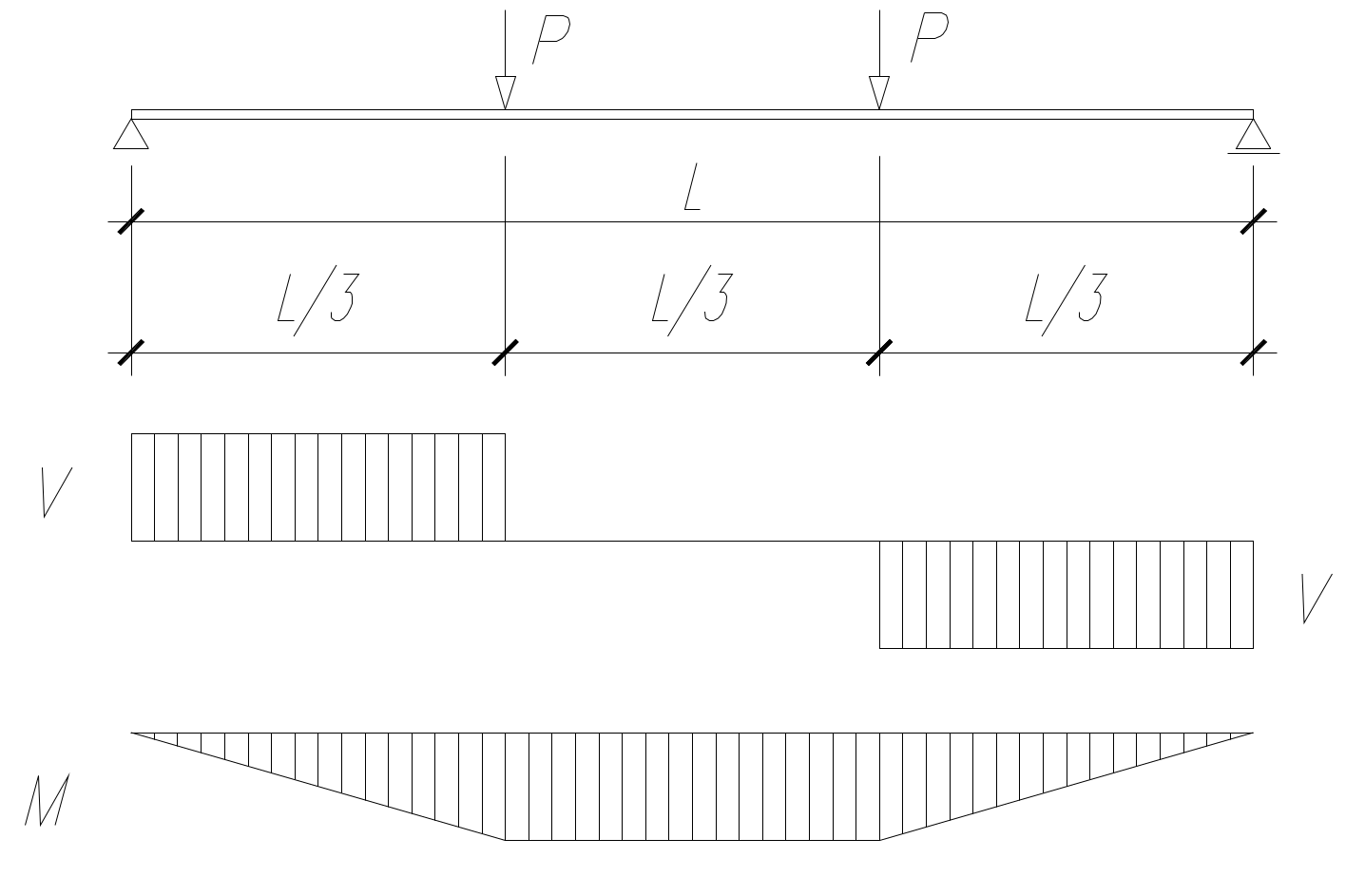
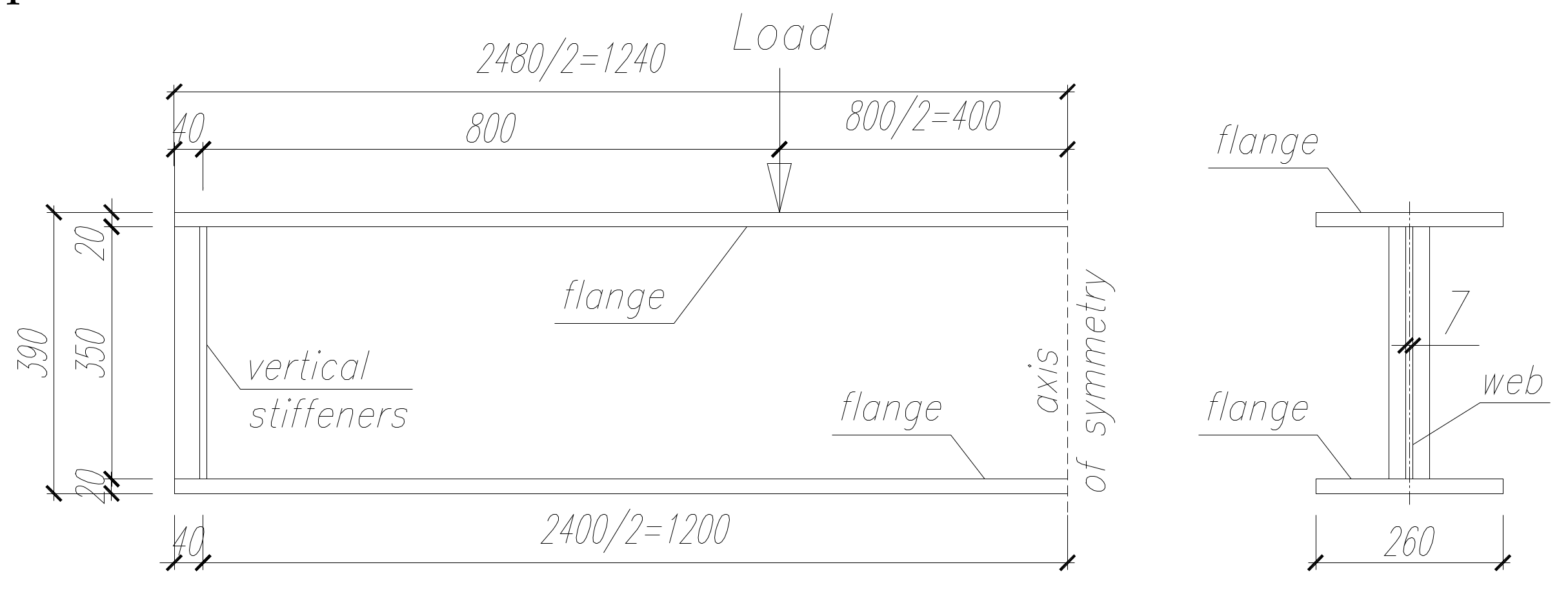
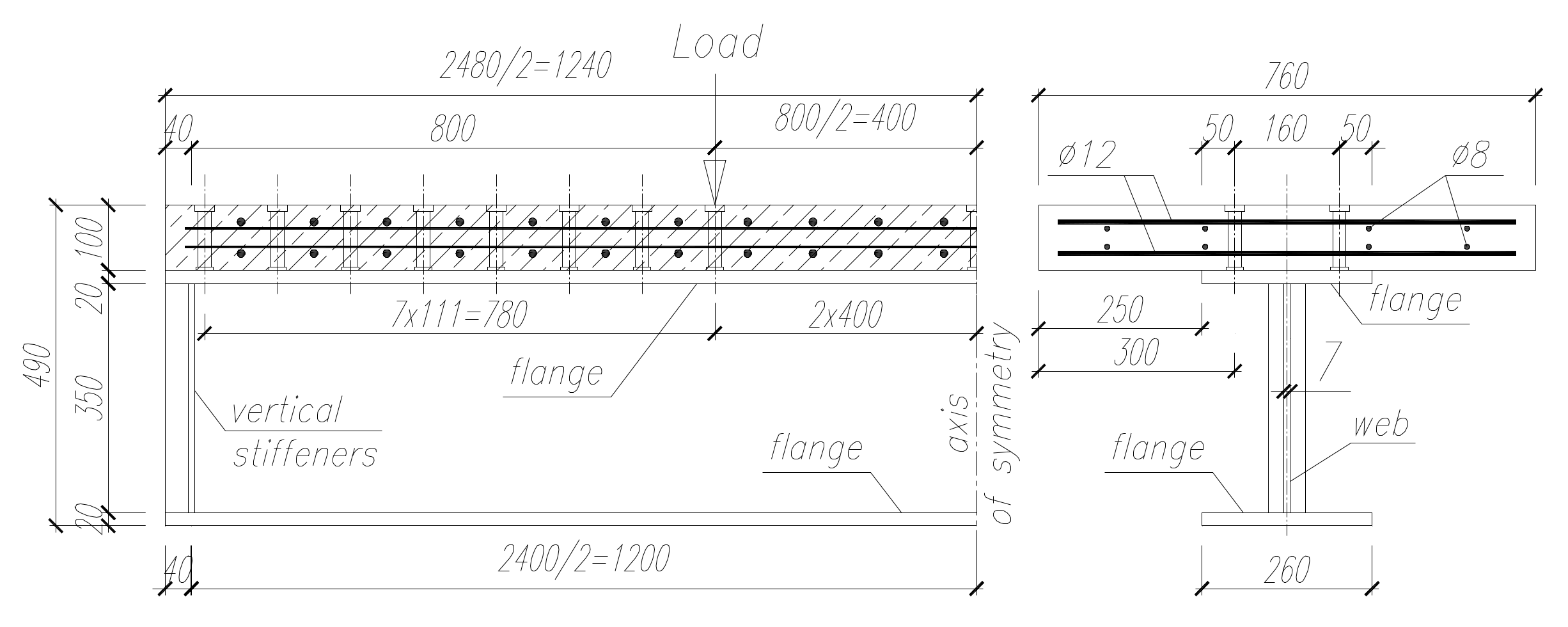
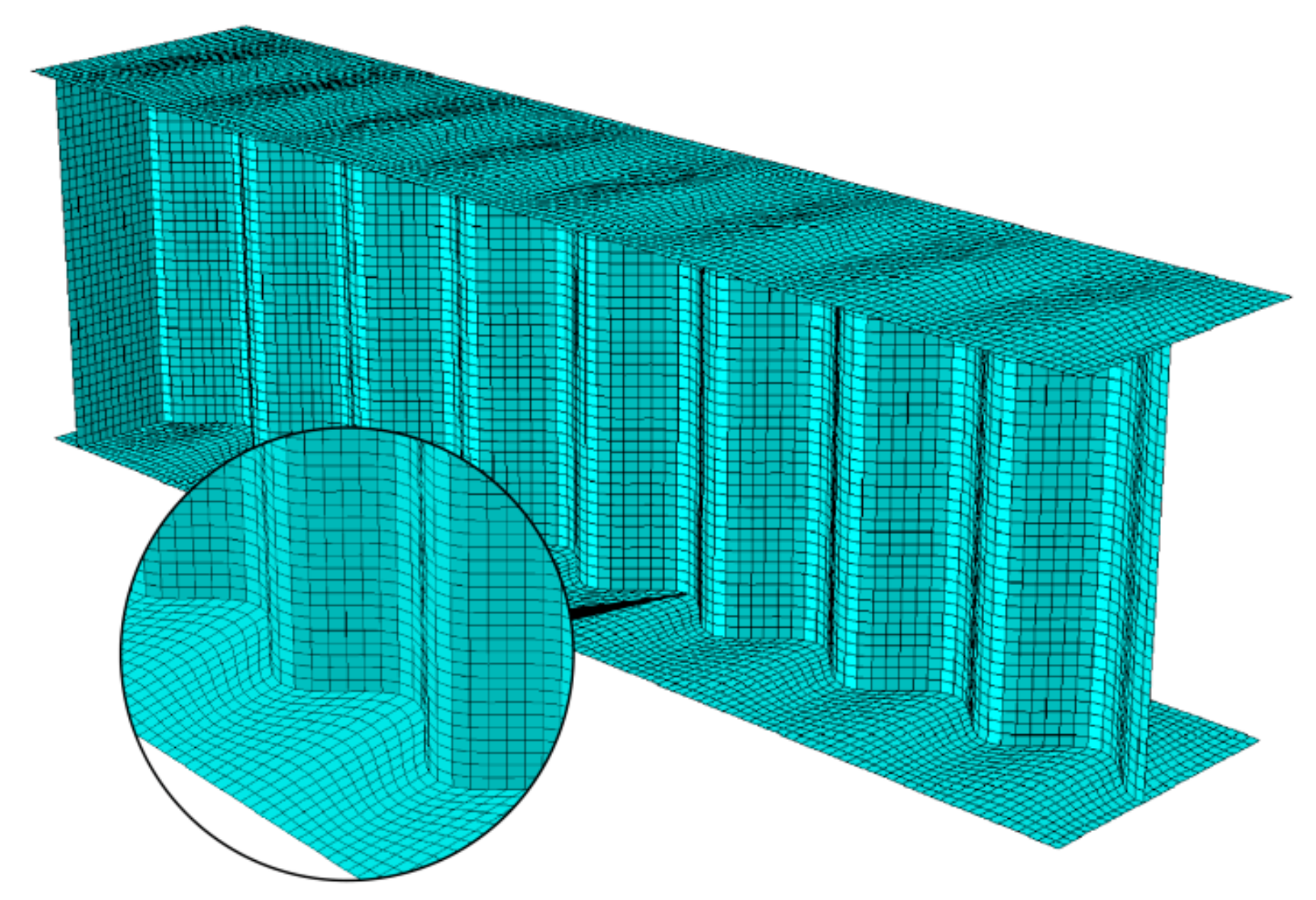
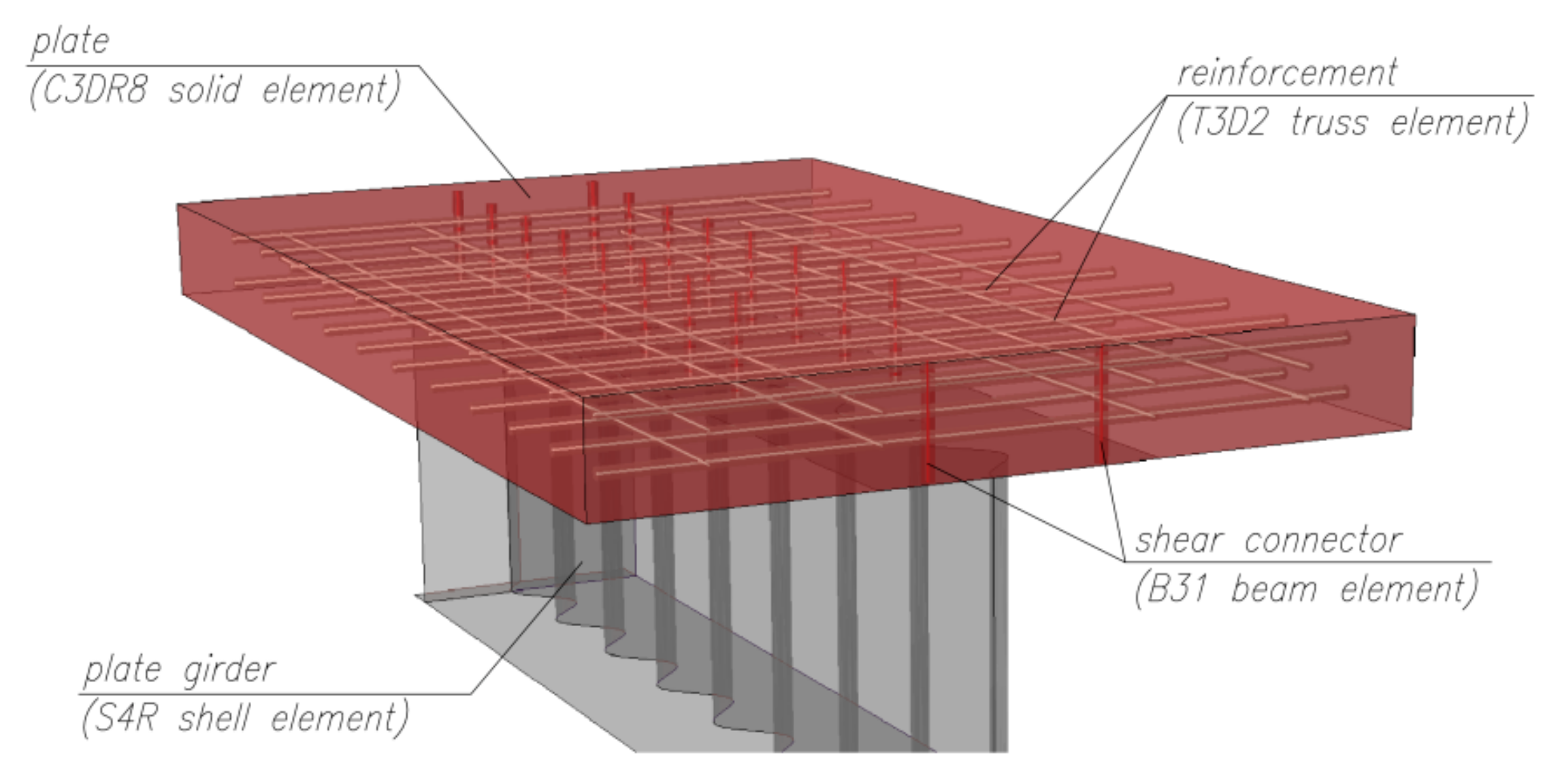
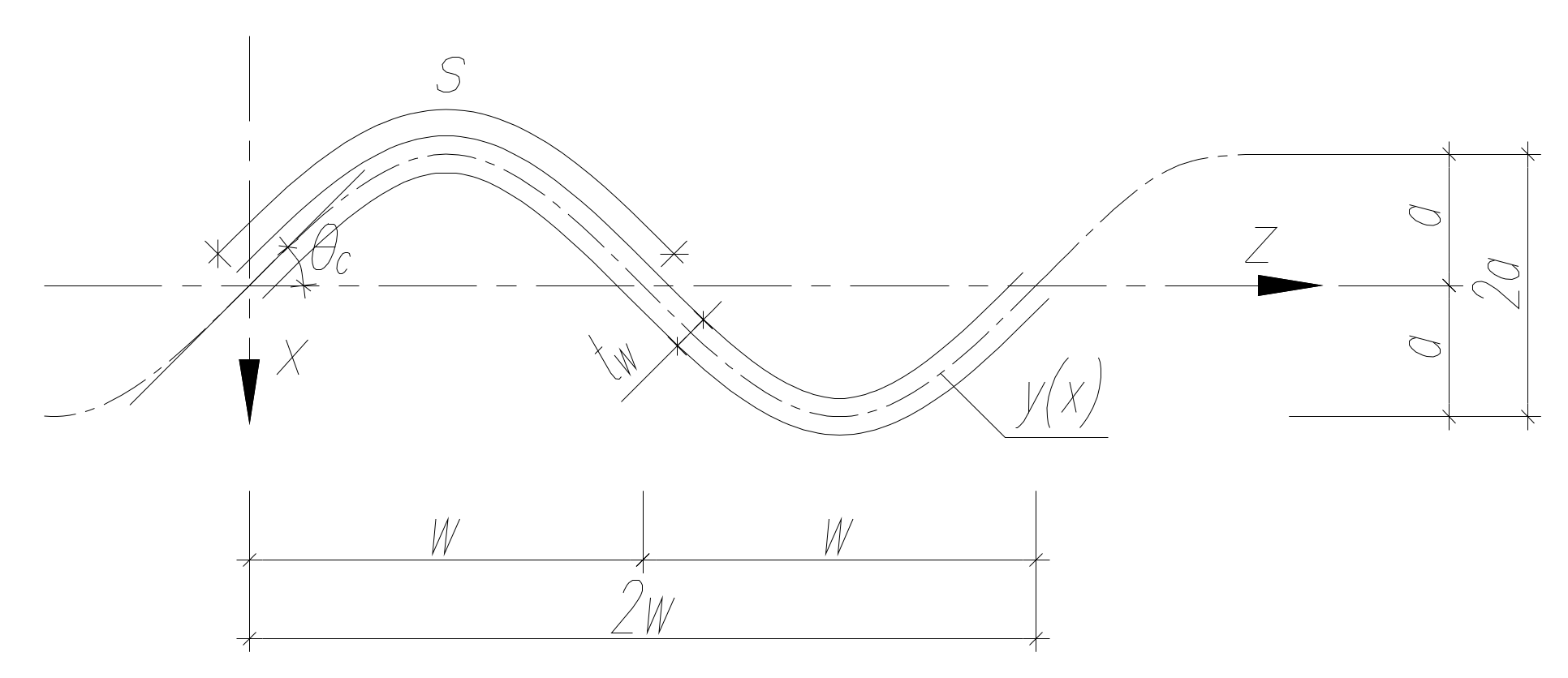
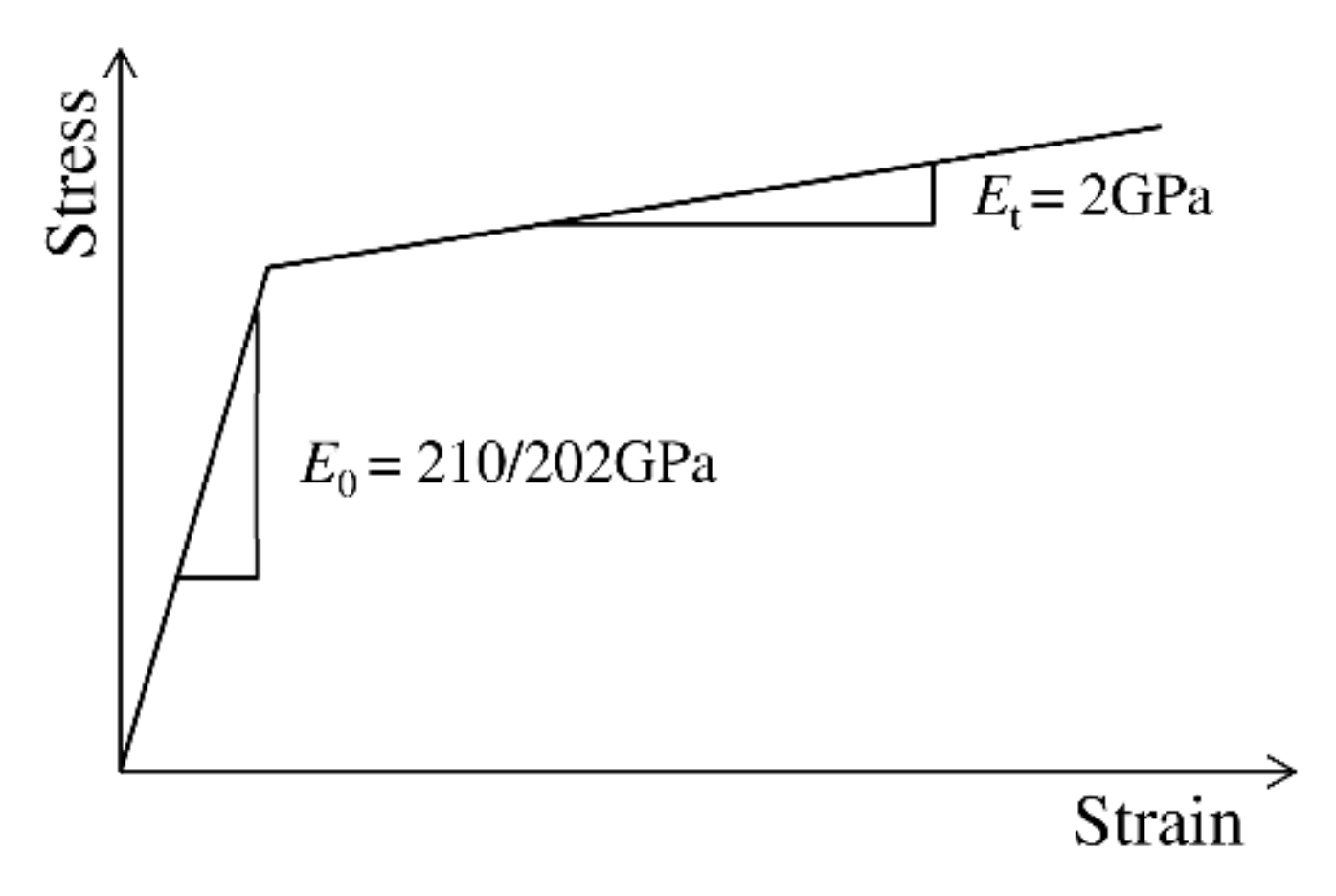

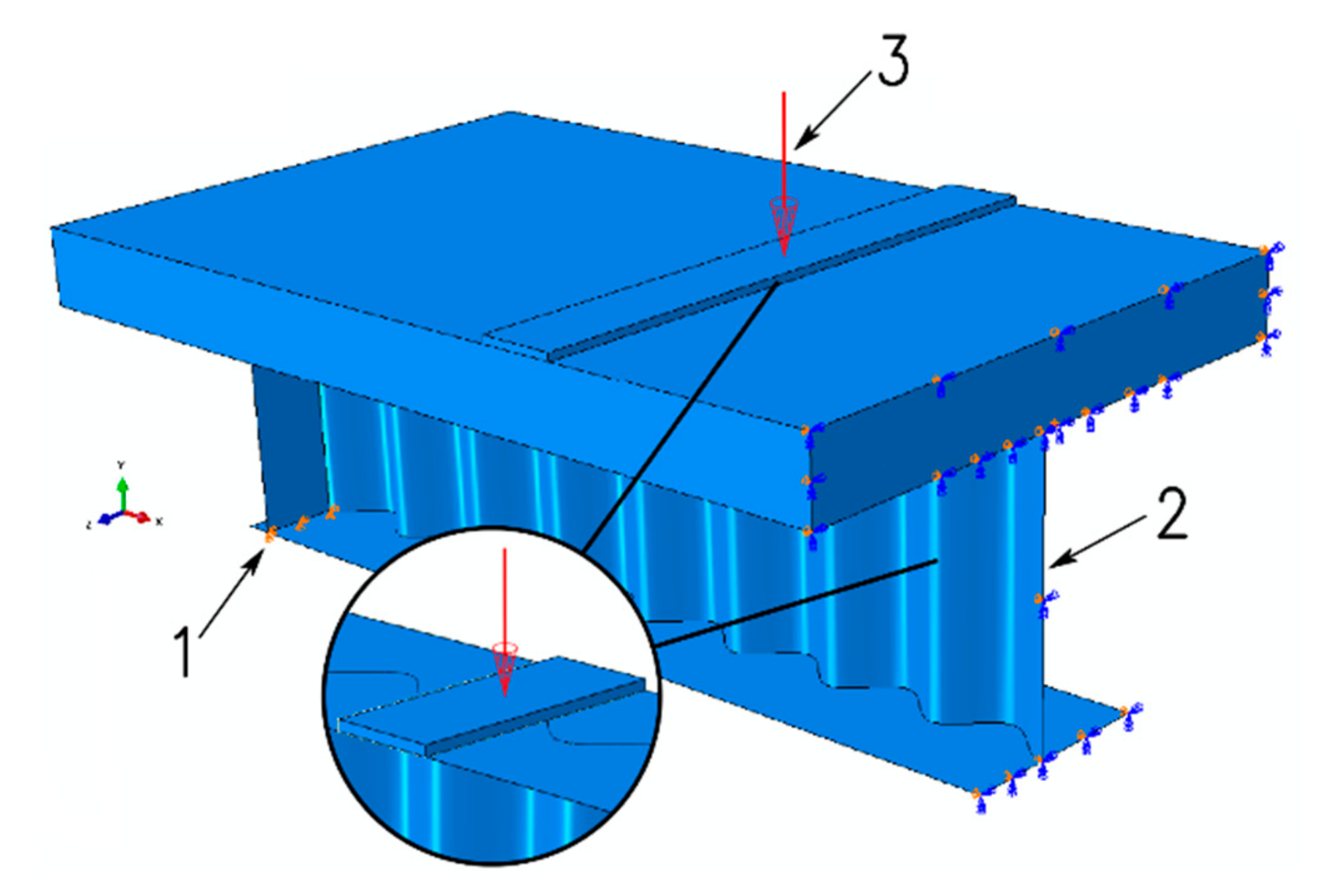
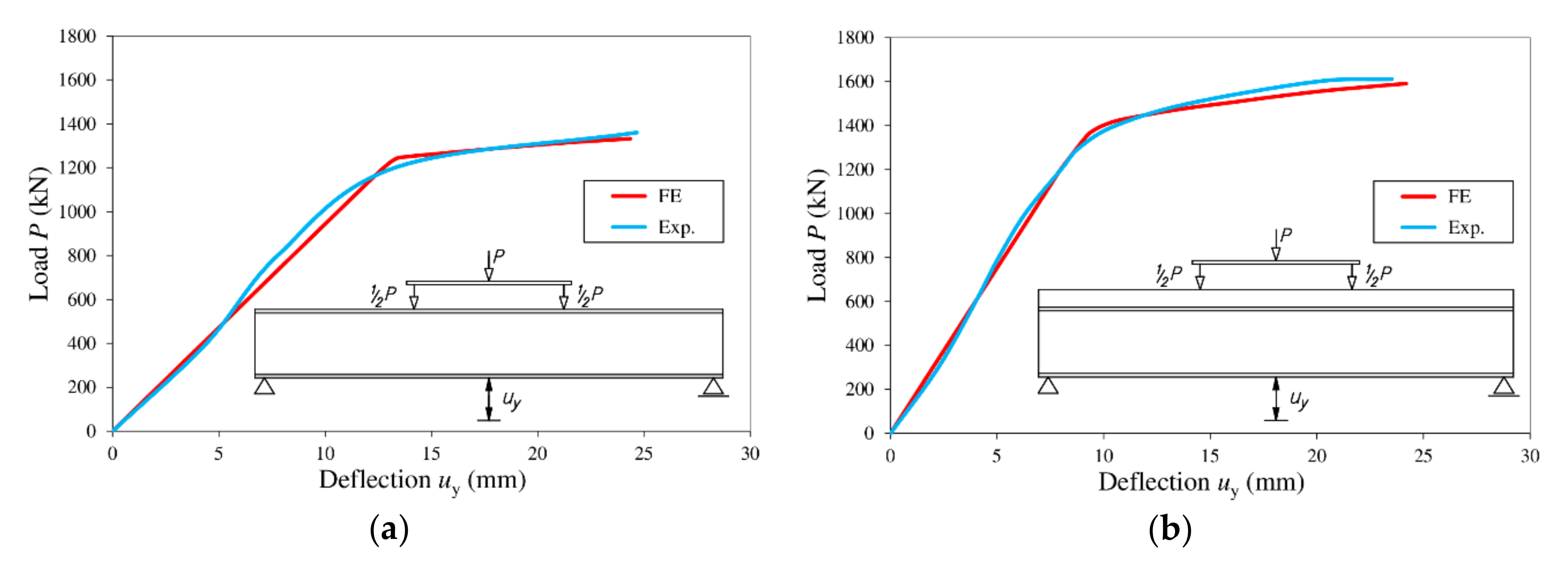
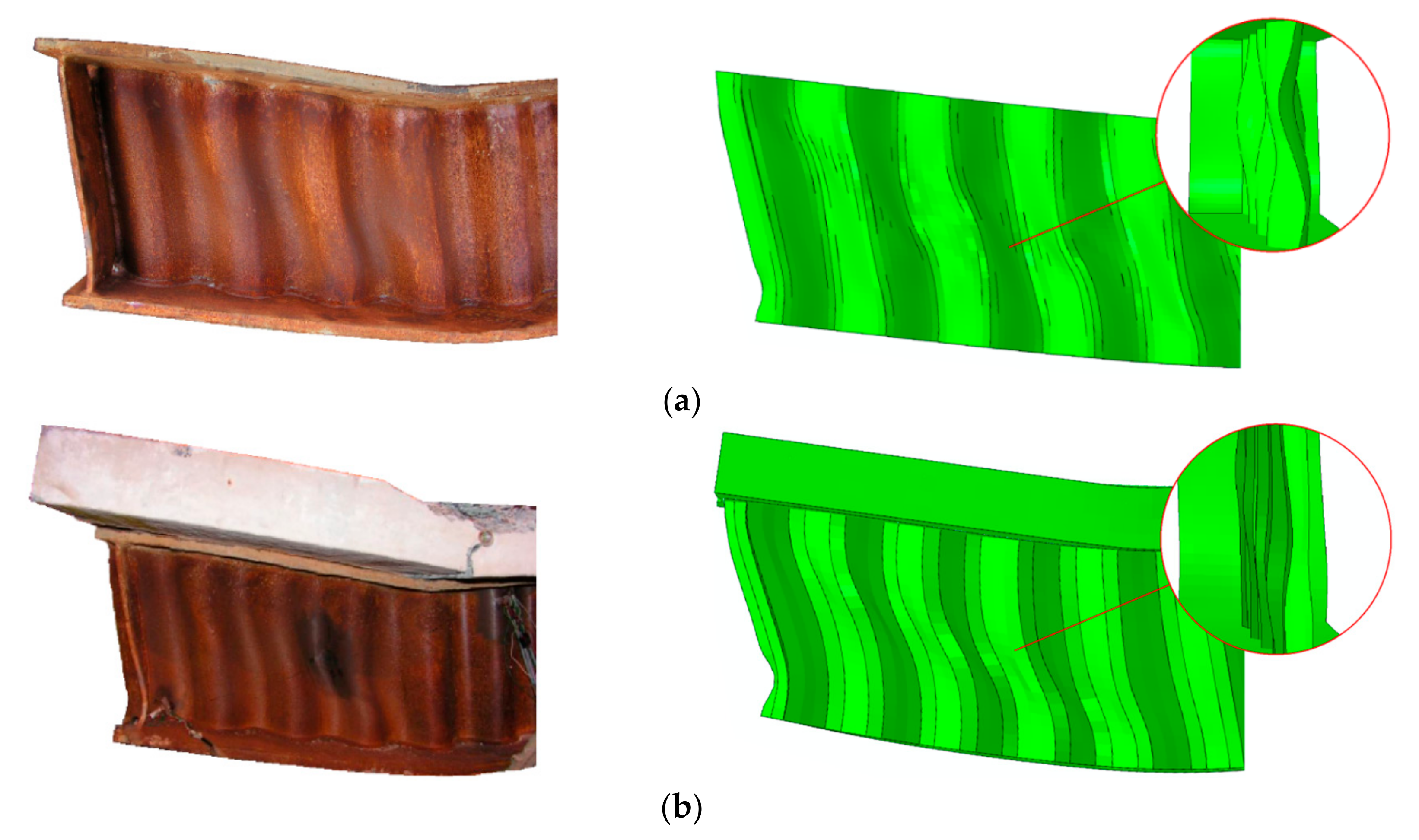
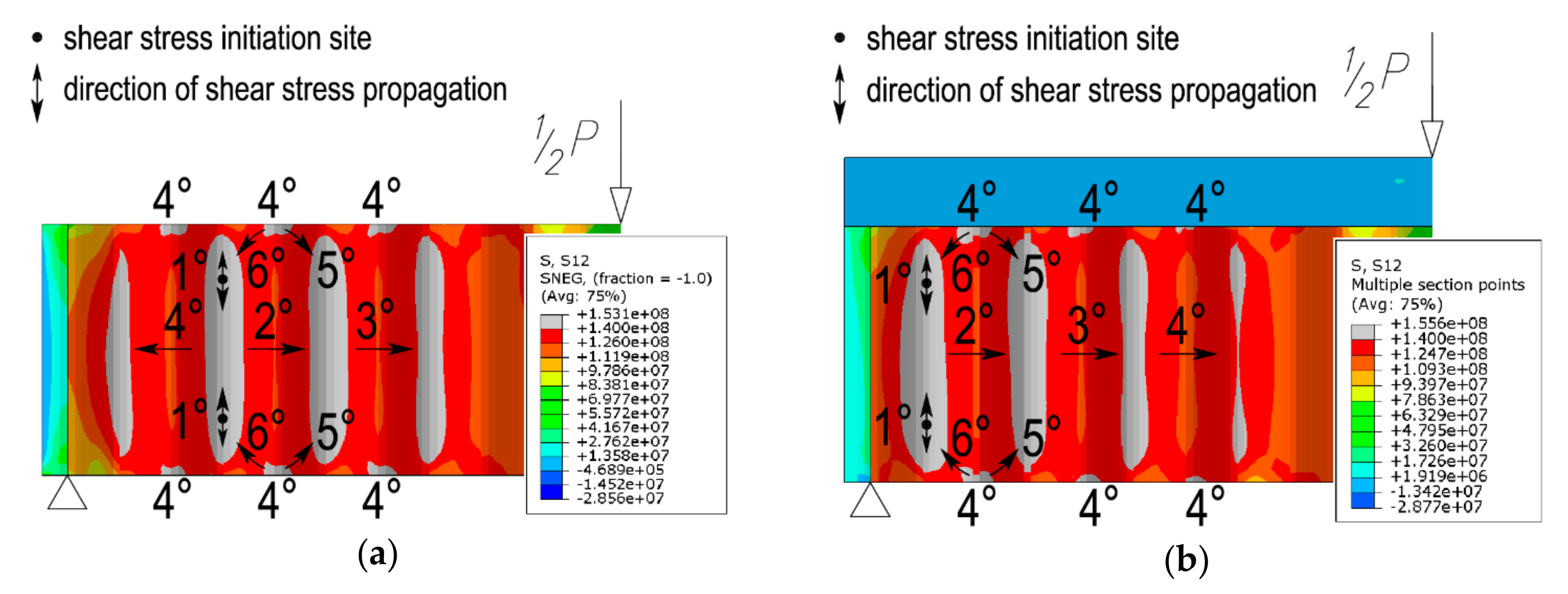
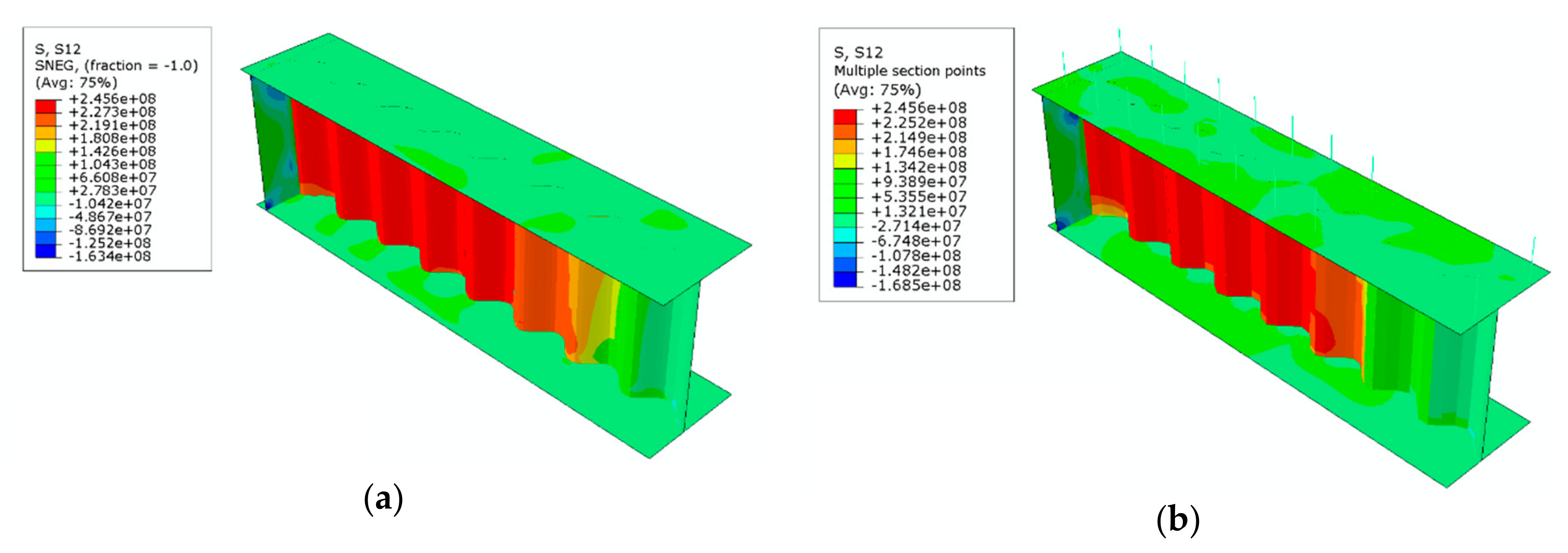
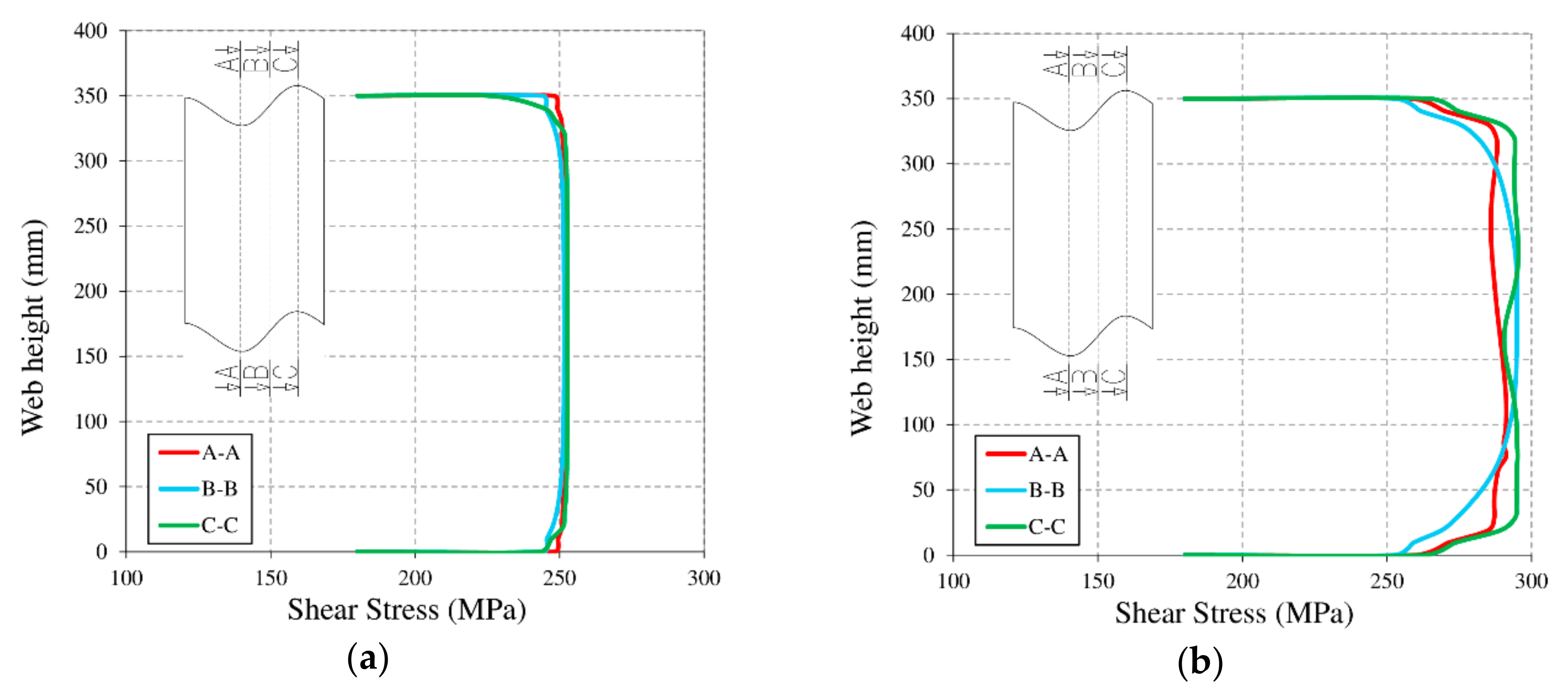
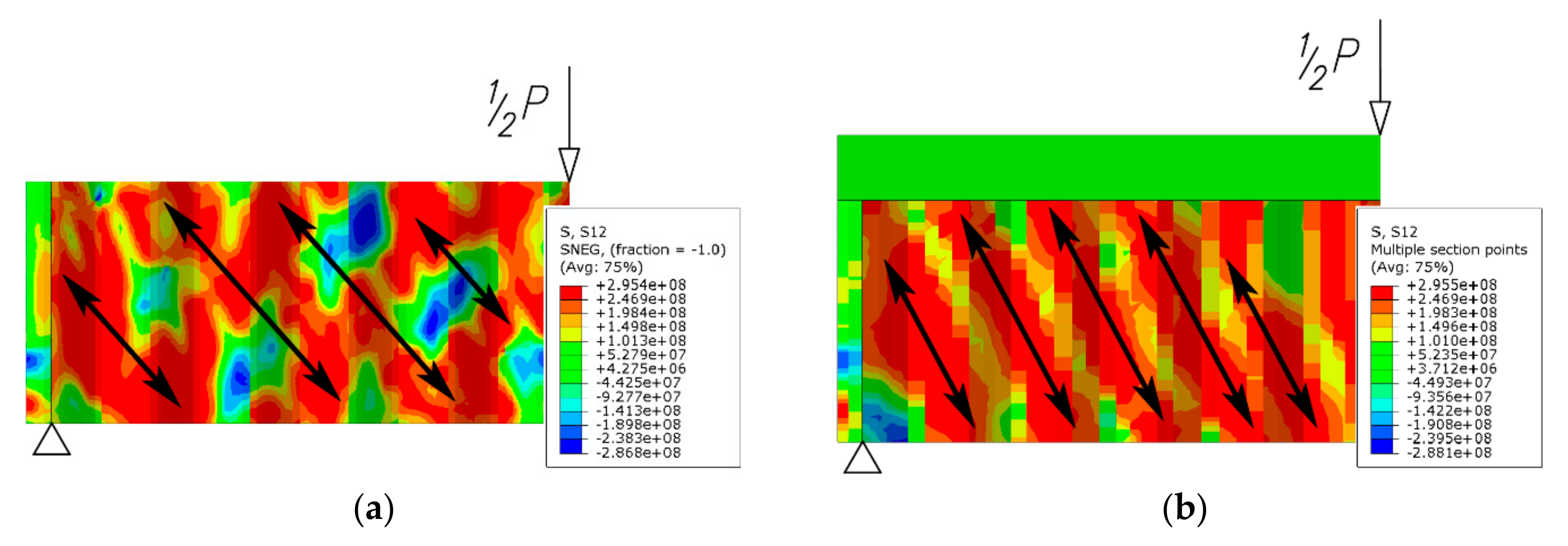
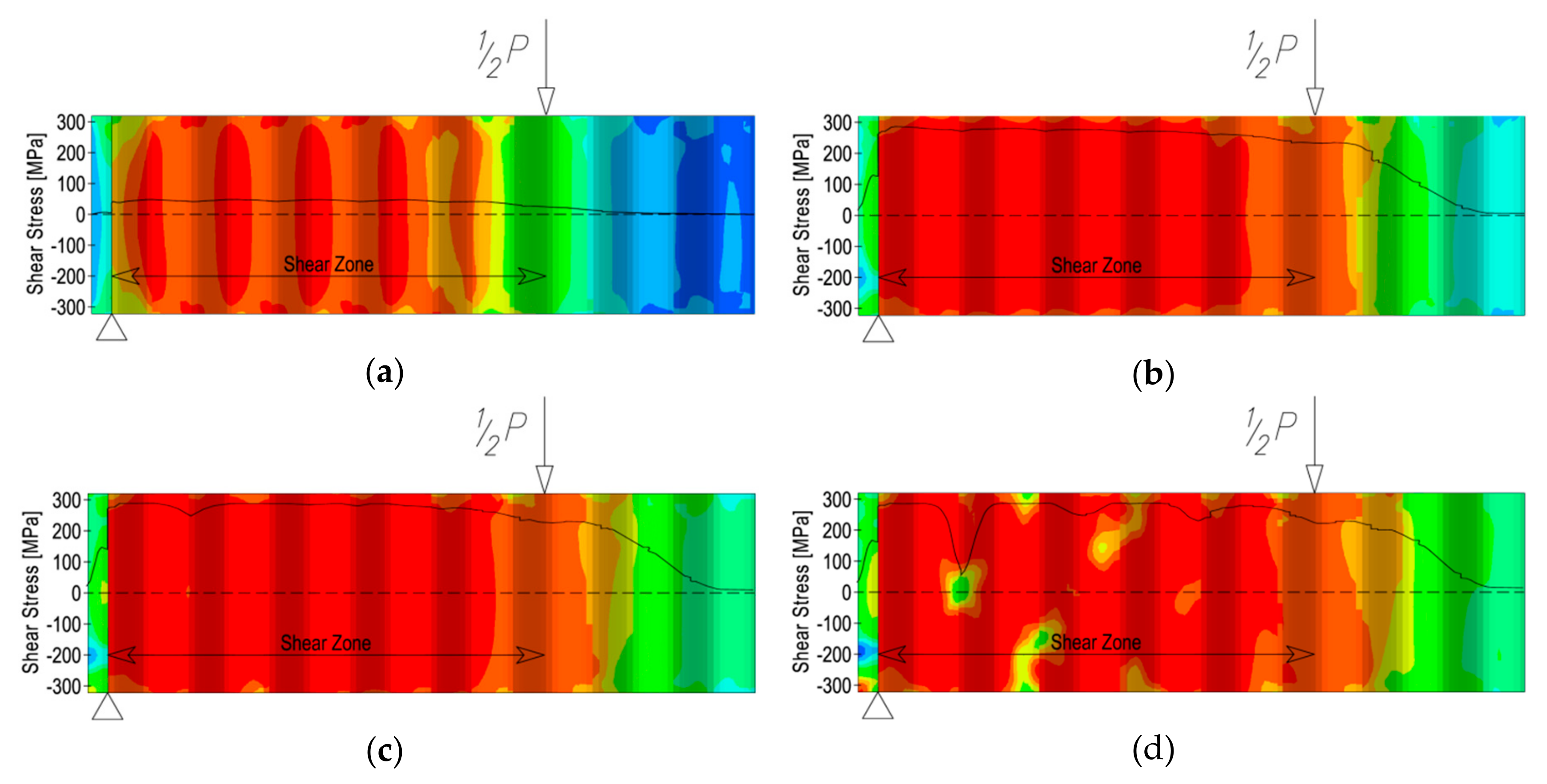
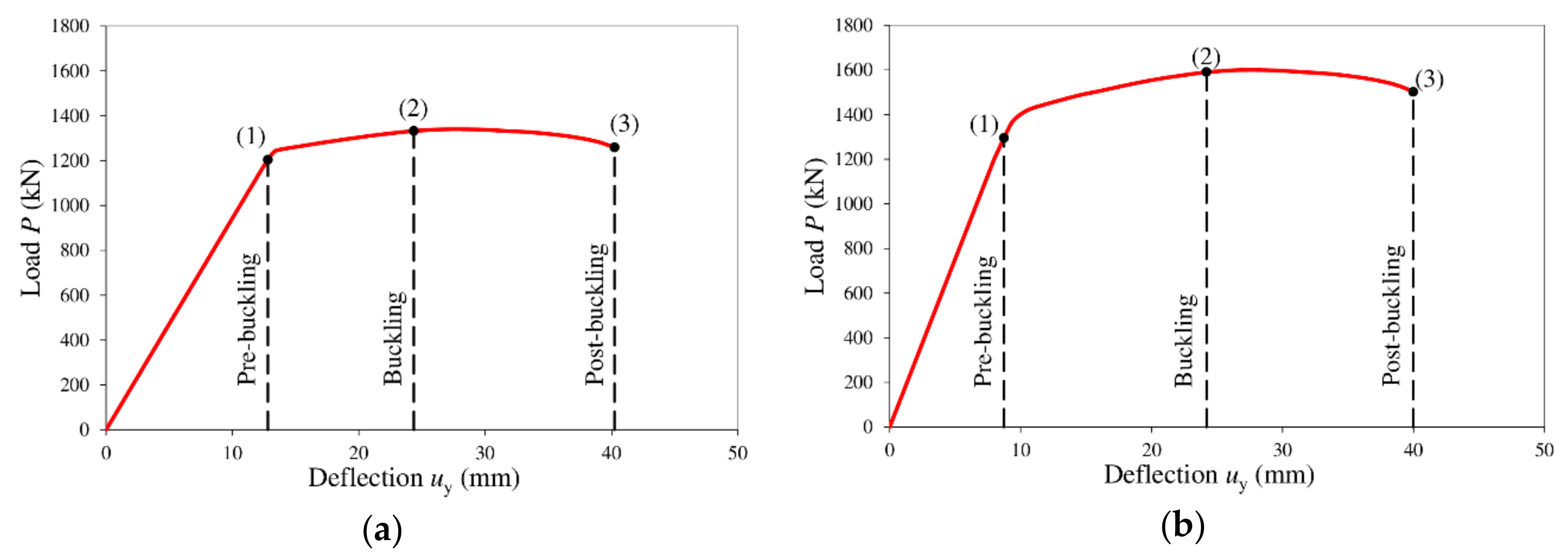
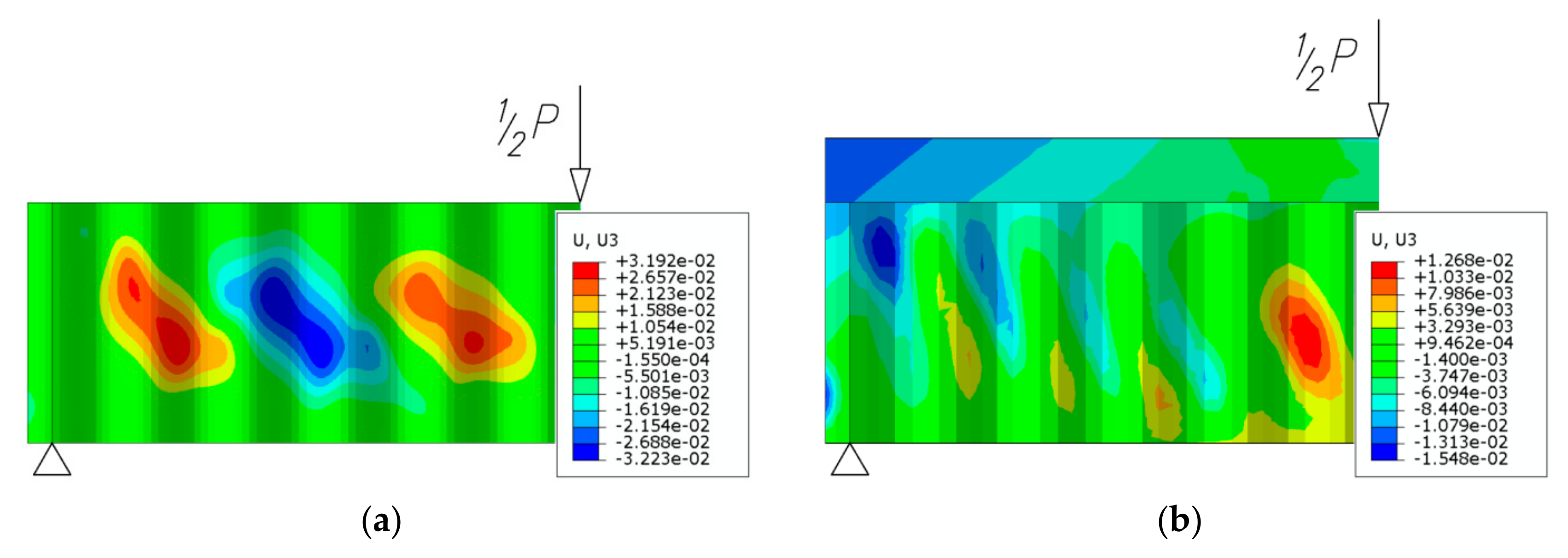
| Material Characteristics | Flanges | Stiffeners | Web | Connecting Fasteners | Rebars |
|---|---|---|---|---|---|
| Yield point (Mpa) | 501.0 | 501.0 | 434.0 | 350.0 | 410.0 |
| Tensile strength (Mpa) | 591.0 | 591.0 | 512.0 | 450.0 | 550.0 |
| Young’s modulus (Gpa) | 210.0 | 210.0 | 202.0 | 210.0 | 210.0 |
| Shear modulus (Gpa) | 81.0 | 81.0 | 78.0 | 81.0 | 81.0 |
| Poisson ratio (–) | 0.3 | 0.3 | 0.3 | 0.3 | 0.3 |
| Internal Friction Angle β | Eccentricity of the Plastic Potential є | fb0/fc0 | Shape of the Plastic Potential Surface Kc | Viscosity Parameter μ |
|---|---|---|---|---|
| 36° | 0.1 | 1.16 | 0.667 | 0 |
| Object under Test | Pult (kN) | uult (mm) | ||
|---|---|---|---|---|
| Exp. | FE | Exp. | FE | |
| Steel beam | 1360.49 | 1332.71 | 24.65 | 24.35 |
| Composite steel–concrete beam | 1611.28 | 1590.80 | 23.52 | 24.19 |
© 2020 by the authors. Licensee MDPI, Basel, Switzerland. This article is an open access article distributed under the terms and conditions of the Creative Commons Attribution (CC BY) license (http://creativecommons.org/licenses/by/4.0/).
Share and Cite
Śledziewski, K.; Górecki, M. Finite Element Analysis of the Stability of a Sinusoidal Web in Steel and Composite Steel-Concrete Girders. Materials 2020, 13, 1041. https://doi.org/10.3390/ma13051041
Śledziewski K, Górecki M. Finite Element Analysis of the Stability of a Sinusoidal Web in Steel and Composite Steel-Concrete Girders. Materials. 2020; 13(5):1041. https://doi.org/10.3390/ma13051041
Chicago/Turabian StyleŚledziewski, Krzysztof, and Marcin Górecki. 2020. "Finite Element Analysis of the Stability of a Sinusoidal Web in Steel and Composite Steel-Concrete Girders" Materials 13, no. 5: 1041. https://doi.org/10.3390/ma13051041
APA StyleŚledziewski, K., & Górecki, M. (2020). Finite Element Analysis of the Stability of a Sinusoidal Web in Steel and Composite Steel-Concrete Girders. Materials, 13(5), 1041. https://doi.org/10.3390/ma13051041





